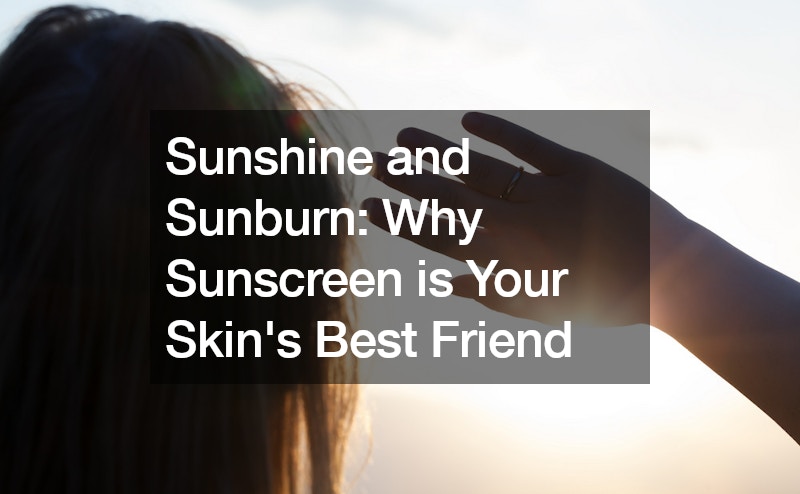Disclaimer: The Purple Feather. This site provides fashion and lifestyle content for informational purposes only.
When we think of the sun, we often associate it with warmth, vitality, and happiness. Basking in its rays on a beautiful day can be a joyous experience, but beneath its radiant exterior lies a hidden danger: ultraviolet (UV) radiation. While the sun provides us with essential vitamin D and lifts our spirits, overexposure to its UV rays can wreak havoc on our skin, leading to sunburn, premature aging, and even skin cancer.
To shield ourselves from these harmful effects, we turn to sunscreen – our skin’s best friend in the battle against sun damage. But what exactly makes sunscreen so essential, and how does it work to protect our skin?
First and foremost, it’s imperative to grasp the distinction between the primary categories of UV rays emitted by the sun: UVA and UVB. UVB rays induce sunburn, whereas UVA rays infiltrate deeper layers of the skin, fostering premature aging and heightening the likelihood of skin cancer.
Given the substantial risks posed by both types of rays, safeguarding against their effects emerges as a top priority for maintaining skin health.
Enter sunscreen: a vital tool in our arsenal against sun damage. Sunscreen works by either physically blocking or chemically absorbing UV rays, depending on the type. Physical blockers, such as zinc oxide and titanium dioxide, form a protective barrier on the skin’s surface, reflecting UV rays away from the skin. On the other hand, chemical blockers absorb UV rays, neutralizing their harmful effects before they can penetrate the skin.
The importance of sunscreen cannot be overstated, regardless of skin type or tone. While individuals with darker skin may have some built-in protection against sunburn, they remain vulnerable to the damaging effects of UVA rays. Children, in particular, require special attention when it comes to sun protection, as their delicate skin is more susceptible to sun damage. UV clothing shops offer a wide range of protective clothing options for children, including hats, shirts, and swimwear, designed to shield their skin from harmful UV rays.
But sunscreen isn’t just for sunny days at the beach – it should be a daily essential in everyone’s skincare routine. Even on cloudy days, UV rays can penetrate through the clouds and cause damage to our skin. Therefore, incorporating sunscreen into our daily skincare regimen is crucial for maintaining healthy, youthful-looking skin.
When selecting a sunscreen, there are a few key factors to consider. Look for a broad-spectrum formula that provides protection against both UVA and UVB rays. Additionally, opt for a sunscreen with a sun protection factor (SPF) of at least 30, which indicates the level of protection it offers against UVB rays. Water resistance is also essential, especially if you’ll be spending time swimming or sweating outdoors.
Applying sunscreen correctly is just as important as choosing the right formula. Aim to apply sunscreen generously to all exposed skin areas, including the face, neck, arms, and legs. Don’t forget about often overlooked areas, such as the ears, lips, and tops of the feet. Be sure to reapply sunscreen every two to three hours, especially if you’re swimming or sweating heavily.
In addition to sunscreen, incorporating other sun protection measures into your routine can further reduce your risk of sun damage. Seek shade whenever possible, especially during the peak hours of 10 a.m. to 4 p.m. Wear protective clothing, such as hats, sunglasses, and UV-protective clothing from UV clothing shops. These clothing items are specifically designed to block harmful UV rays, offering an extra layer of defense against sun damage.
Furthermore, it’s essential to understand the long-term effects of sun exposure on our skin. Chronic sun exposure can lead to photoaging, characterized by the development of wrinkles, fine lines, and age spots. UV rays break down collagen and elastin fibers in the skin, resulting in a loss of elasticity and firmness. Over time, this can lead to premature aging and a dull, uneven complexion.
Furthermore, being exposed to the sun without protection heightens our susceptibility to skin cancer, which stands as the most prevalent form of cancer on a global scale. Basal cell carcinoma, squamous cell carcinoma, and melanoma emerge as the primary categories of skin cancer, with all of them linked to UV radiation from the sun. Although basal and squamous cell carcinomas occur more frequently and exhibit lesser aggressiveness, melanoma poses as the most lethal variant, capable of swiftly spreading if not identified and addressed promptly.
In conclusion, sunscreen is a vital tool in protecting our skin from the harmful effects of the sun. By incorporating sunscreen into our daily skincare routine and taking additional sun protection measures, we can enjoy the benefits of sunshine while minimizing the risk of sunburn, premature aging, and skin cancer. So, the next time you step outside, don’t forget to slather on the sunscreen – your skin will thank you for it.
.


